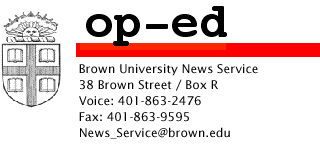

|
Distributed February 2001 Copyright ©2001 by Warren Simmons and Marla Ucelli |
Op-Ed Editor: Janet Kerlin About 780 Words |
|
Warren Simmons and Marla Ucelli School reform plans should include urban school districts With heavy reliance on rewards and punishments, the Bush educational reform plan seems to imply that incentives alone will encourage schools to lift themselves out of failure. The plan pays scant attention to the one institution that can make sure there are good schools for all students: the urban school district. President Bush’s education plan – with its emphasis on meeting the needs of poor and minority children, especially those in our inner cities—is welcome rhetoric from a Republican administration. Focusing the nation’s attention on issues of equity, the Bush plan holds real promise for closing the achievement gap and providing help where it’s needed the most. Not surprisingly, attention has focused on the hot-button issue in the plan: school vouchers that would enable parents to move their children from a chronically failing school to a more successful public or non-public school. But the real issue that must be addressed is not how to help children flee a failing school; it is how best to ensure that every school can successfully educate all its students, so that no child is left behind. With heavy reliance on rewards and punishments, the Bush plan seems to imply that incentives alone will encourage schools to lift themselves out of failure. But the plan pays scant attention to the one institution that can make sure there are good schools for all students: the urban school district. In the ebb and flow of school reform debate during the last decade, the school district has been all but ignored. Some decry it as a patronage haven; others point to bureaucratic ineptitude; many see it as an obstacle to reform and have called for abolishing it or at least limiting its authority over schools. Those who have argued for abolishing or bypassing school districts contend that schools should be set free from the impediments of the district bureaucracy and have the freedom to do what they think is best for students. But recent research makes clear that simply giving schools autonomy will not solve the problem of poor performance for all urban schools. Improving teaching and learning takes more than stripping away impediments; it also takes the knowledge to understand how to transform teaching practices and implement new techniques. Some schools will be able to take advantage of this freedom and improve their performance but most will not. Why? City schools need some kind of external support to help them constantly update teacher’s skills and knowledge, reduce inequities in the allocation of funds, access economies of scale, be publicly accountable, and, above all, support better teaching of subjects and skills. School districts can provide such supports, although they might not be the only option. But districts have real advantages, First, districts exist. It is easier to reform an existing entity than to replace it with something new. Second, as political organizations, school districts must maintain a connection to the community at large. This is important now, if schooling is to remain a public good worthy of taxpayer support, especially when the vast majority of adults don’t have children in school. Third, districts can bring substantial resources to bear in schools. In many cases, they can raise and spend tax dollars, providing a steady stream of revenue. School districts can also recruit, retrain and re-deploy teachers, principals and administrators. Most important, school districts offer a natural venue to seek an effective solution to the problems of equity and urban schools. Too often, the schools that are allowed to fail serve minorities, the poor and recent immigrants. Districts are responsible for all schools. Without some such entity accountable for a city’s entire student population, the gaps between the succeeding and failing schools will widen. The failures of many urban school systems have chipped away at their legitimacy. Nonetheless, recent studies of reforming districts suggest that they can provide the support schools need and narrow the achievement gap. President Bush does not have to look far to see a prominent example of a school district at the vanguard of reform. His secretary of education, Rod Paige, has led improvements in the Houston Independent School District by focusing on accountability, teamwork, efficiency and experimentation. Successful strategies such as these are the subject of a five-year effort to study promising educational and organizational practices, test them in urban communities and share the most effective strategies with policymakers, educators and the public. The effort, known as School Communities that Work: A national task force on the future of urban districts, is a project of the Annenberg Institute for School Reform at Brown University and funded by the Carnegie Corporation of New York, and the Annenberg, Rockefeller, Pew and Ford foundations. Until his recent appointment, Paige was a participant in the task force and shared his experiences in Houston with the other members. We share President Bush’s commitment to ensure that no child is left behind. We think that using districts to create communities of schools that work is a good place to begin. Warren Simmons is executive director of the Annenberg Institute for School
Reform at Brown University. ###### | |